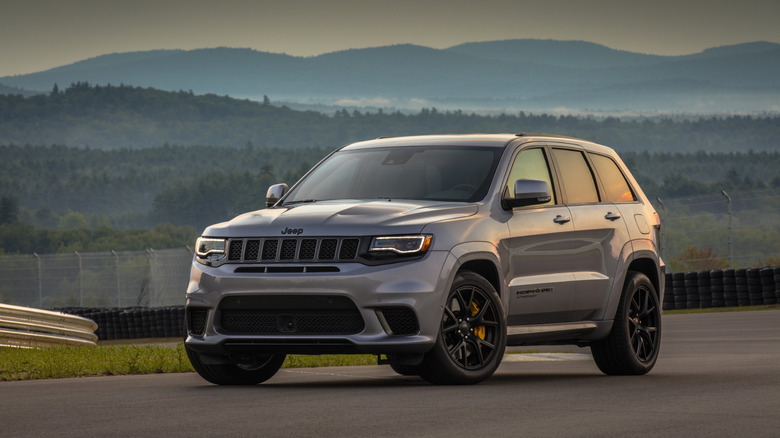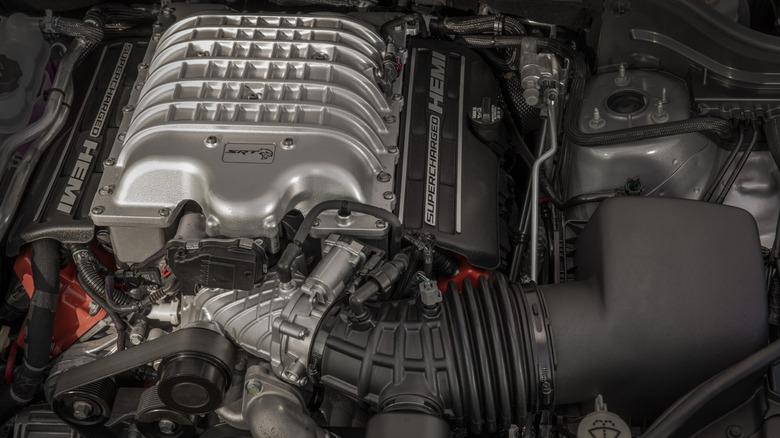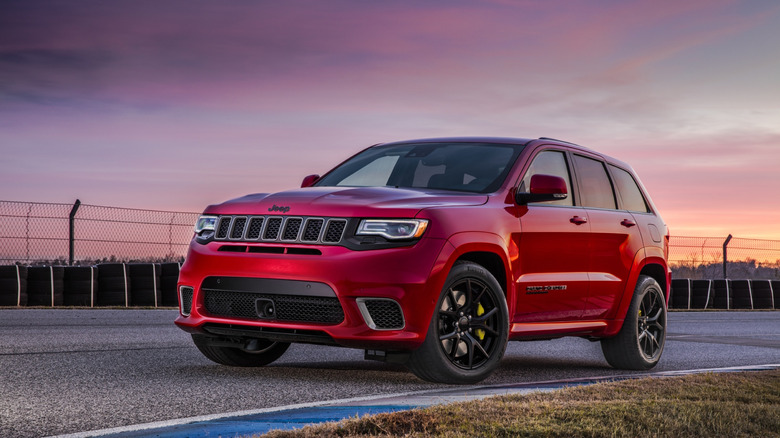Could Jeep Make A New Grand Cherokee Trackhawk?
There's a number of AI-generated images and videos like this floating around the Internet right now, capitalizing on the popularity of the original Jeep Grand Cherokee Trackhawk. Sadly, every one of these is fake; Jeep has no currently known plans for a new Trackhawk. That's because it wouldn't make a good deal of business sense from Stellantis' perspective, considering the state of the suffering American automotive industry as a whole (and Stellantis in particular).
Following the Trackhawk's demise in 2021, Stellantis has since axed or otherwise neutered a number of its popular muscle cars as part of their overall rebranding efforts. Take for example the Dodge Challenger and the previous-generation Charger, both discontinued in 2023for model year 2024; these were the victims of Stellantis' attempt at refocusing their priorities towards cleaner, more environmentally friendly vehicles with a particular emphasis on EVs.
V8-equipped muscle cars – and certainly muscle SUVs – simply had no place in such a lineup, and so Stellantis halted production of a number of these iconic (but largely inefficient) vehicles. As for the Trackhawk, considering the fact that it's just a souped-up Grand Cherokee powered by a Hellcat supercharged Hemi, it stood absolutely no chance of making it over the hill that Stellantis placed before it. This led to its untimely demise after just four model years and indeed may represent the end of its story entirely.
What made the Trackhawk so special?
Chrysler has a long and proud history of shoving the most obscenely large engines into inappropriate platforms and somehow making it work. Take the 2004 Dodge Ram SRT-10 for example, one of the coolest trucks of the 2000s, boasting the complete powertrain of a Viper. Why on Earth Chrysler would do this is anyone's guess, but enthusiasts everywhere rejoiced at the sheer lunacy of it, a trend which continued right up to the Trackhawk's introduction.
It was the fastest and most powerful SUV ever produced at the time, thanks to its 707-horsepower supercharged Hemi ripped from the Challenger Hellcat. This monstrosity covered a quarter-mile in 11.4 seconds and hit 180 miles per hour, reaching 60 in just 3.5 seconds. Those are proper supercar numbers filling the spreadsheet of, let's be honest here, a family-oriented SUV. Just imagine owning a Lamborghini and being smoked by a Jeep, of all things. That's the level of sleeper-potential this thing had, and why it was so popular.
Granted, all of that performance came at a cost to both the wallet and the truck's capability. The actual sticker price of a Trackhawk easily hit $100,000 or more, quite the sacrifice for what ultimately amounts to a gimmick car. There's no way this massive 5300+ pound SUV could ever compete on-track with something like a Lamborghini; that's simply not the Grand Cherokee's design philosophy. Nor was it versatile off-road (that's the Trailhawk's job). Rather, it was primarily a luxury SUV and marketed as such. But it also had an engine sound that was special enough for many enthusiasts.
Why the Trackhawk (likely) won't return
This ties in with two factors currently affecting Stellantis – let's start with the powertrain drama. Essentially, Chrysler faced massive backlash for its decision to drop the Hemi in their truck lineup; so much so that they will officially restart its production. Even more significantly, they will fit the Hemi to the all-new Charger Daytona, a platform which Chrysler developed principally as an EV with an available twin-turbo straight-six. In other words, Stellantis will effectively retrofit the Charger Daytona with the Hemi as a result of all the outrage, a process which won't be completed until 2026. As for which Hemi, that's up for debate as of the time of this writing. But if it's the supercharged 6.2, then we'll now have all the necessary ingredients for a Trackhawk in-place.
Let's suppose the best-case scenario occurs and we will indeed see the 6.2L supercharged Hemi return. That's already quite a few stars aligned, but it likely won't be enough, and that's due to the other factor affecting the entire automotive industry: the tariffs. The announcement of the 25% tariff plunged Stellantis shares literally overnight, and the CEO responsible for Stellantis' change of direction, Carlos Tavares, abruptly resigned on December 1, 2024. All this occurred during an industry-wide sales slump, and that's before we even consider the anticipated future impact of tariffs on Stellantis. This means that, unfortunately, while the Trackhawk may return at some point, it likely won't see the light of day until the situation radically changes for Stellantis as their priorities shift towards inexpensive, easily produced, mass-market vehicles.


